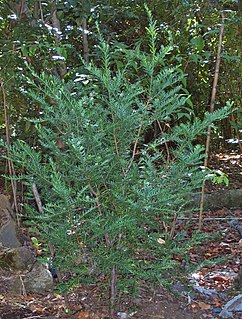Related Research Articles

The Valdivian temperate forests (NT0404) is an ecoregion on the west coast of southern South America, in Chile and extending into Argentina. It is part of the Neotropical realm. The forests are named after the city of Valdivia. The Valdivian temperate rainforests are characterized by their dense understories of bamboos, ferns, and for being mostly dominated by evergreen angiosperm trees with some deciduous specimens, though conifer trees are also common.

Austral University of Chile is a Chilean research university based primarily in Valdivia, with a satellite campus in Puerto Montt. Founded on September 7, 1954, it is one of the eight original Chilean Traditional Universities. It operates as a nonprofit self-owned corporation under private law, and receives significant state-funding.

Prumnopitys andina, the lleuque or Chilean plum yew, is an evergreen coniferous tree native to south-central Chile and a few areas in adjacent parts of westernmost Argentina from 36 to 40° South latitude. It lives on moderately wet soils, preferably on Andean slopes from 500–1,100 meters (1,600–3,600 ft).

Podocarpus nubigenus is a species of podocarp, endemic to the Valdivian temperate rain forests of southern Chile and adjacent southwestern Argentina. It is the southernmost podocarp in the world. It grows from 38°S to Ultima Esperanza (53°S), in wet and swampy soils. It can settle clear grounds, with a faster growth than the other Chilean Podocarpaceae.

Gomortega keule is a tree native to Chile. It is the sole species of the genus Gomortega and, according to the APG IV system of 2016, of the monotypic family Gomortegaceae, assigned to the order Laurales in the clade magnoliids.

Podocarpus salignus, the willow-leaf podocarp, is a species of coniferous evergreen tree in the family Podocarpaceae. It is found only in Chile, from 35 to 42° south latitude, where it is threatened by habitat loss. Growing up to 20 m (66 ft) in height and 1 m (3 ft) in diameter, the trunk is straight and cylindrical, with reddish-gray bark. The arching branches bear long, narrow, willow-like leaves, and red fleshy oval fruits where male and female plants are grown together. In Chile it is known as Mañío de hojas largas (long-leaved).

Nothofagus alpina, also called rauli or raulí beech is a species of plant in the Nothofagaceae family. A deciduous tree, it grows in Chile and Argentina, it reaches 50 m (160 ft) height and more than 2 meters (6.5 feet) in diameter. Its distribution goes from 35 to 42° South latitude. It is found on the Andes. It tolerates low temperatures and heavy winds. It has a straight and cylindrical trunk with grey bark. N. alpina was proposed to be renamed Lophozonia alpina in 2013.

Nothofagus glauca, commonly known as hualo or roble Maulino, is a species of plant in the family Nothofagaceae. It is a deciduous tree endemic to Chile. It grows from 34° to 37° South latitude. N. glauca was proposed to be renamed Lophozonia glauca in 2013. It is a typical tree of the mediterranean Maulino forest of Central Chile, its current range spanning over 330 km from north to south. The species grow on a variety of soils and is mostly found on gentle to steep slopes.

Nothofagus nitida is an evergreen tree, native to southern Chile and Argentina. It is found from latitude 40° S to Última Esperanza.
Rucamanque is a property owned by the Universidad de La Frontera in Chile, with a total area of 435.1 hectares, that is used for research, environmental education, and conservation. Rucamanque is located in south-central Chile, at 376 m of altitude, County of Temuco, Cautın, IX Region, Chile.

Citronella mucronata, the huillipatagua or Chilean citronella tree, is an evergreen tree native to Chile, it occurs from 30 to 41° South latitude. In Chile, the tree grows from 500 to 2000 meters above sea-level in low altitude interior valleys and coastal mountains.
María Catrileo Chiguailaf de Codo is a native Mapuche linguist and professor of Spanish, English and Mapudungun language.
The Chilean Law on Native Forest Recovery and Forestry Development most often referred as the Native Forest Law is a law that regulates the use of native forests and is also aimed to promote sustainable forest management. The Native Forest Law is one of the Chilean laws that have been longest time in the parliament, from 1992 to 2007. It was promulgated in 2008.

Guido Mutis Carrasco was an English literature professor at the Valdivia campus of the Austral University of Chile and director of the Valdivia International Film Festival. During his life he made important contributions to national cinema studies and Chilean literature.

Adriana Elisabeth Hoffmann Jacoby was a Chilean botanist, environmentalist and author. She was executive secretary of Chile's National Environment Commission from 2000 to 2001. She advocated for the sustainable management and protection of Chilean forests, leading opposition to illegal logging in her role as coordinator of Defensores del Bosque Chileno since 1992.
Jürgen Henning Illies was a German geologist, an expert in taphrogenesis. Apart from his work on rifts, including the Rhine Rift Valley, he is revered for his contributions to Chilean geology.
Thomas Thorstein Veblen is an American forest ecologist and physical geographer known for his work on the ecology of Nothofagus forests in the Southern Hemisphere and on the ecology of conifer forests in the southern Rocky Mountains of the U.S.A. He is an Arts and Sciences College Professor of Distinction at University of Colorado at Boulder, USA (2006).

Maulino forest is a forest type naturally growing in the Chilean Coast Range of Central Chile from latitude 35°55 to 36°20 S. The chief tree species is Nothofagus glauca. Other tree species include Nothofagus leonii, Nothofagus alessandri and Gomortega keule. The forest grows at a transition zone between Mediterranean climate to humid temperate climate. Precipitations vary from 1000 to 700 mm/a and are concentrated in winter. According to geographers Humberto Fuenzalida and Edmundo Pisano the forest is one of mesophytes on the transition zone of temperate rain forests.

Otto Dörr Zegers. Medical Surgeon of the University of Chile (1961), Psychiatrist, (Graduate School of the Faculty of Medicine, University of Chile ; Doctor of Medicine Heidelberg University ; specialist in Psychiatry and Neurology, University of Heidelberg ; Specialist in Psychotherapy, University of Heidelberg Emeritus Professor of Diego Portales University, Master of Chilean Psychiatry and National Prize for Medicine in 2018, the paternity of the disease entity "Bulimia Nervosa". Dörr previously described it as “Secondary hyperphagia and vomiting syndrome in young women" in the Chilean Journal of Neuropsychiatry in 1972, an article that was published in English in the “International Journal of Eating Disorders".

Bernardo Alfonso Modesto Donoso Riveros is a Chilean scholar and researcher who served as head of the Pontifical Catholic University of Valparaíso (1990−1998) during the first years of the transition to democracy.
References
- UACh - curriculum vitae
- Universia - Profesor Emérito de la UACh es reconocido por su contribución al desarrollo sustentable del bosque nativo